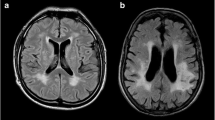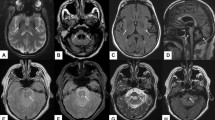Abstract.
The clinical diagnosis of Marchiafava-Bignami disease (MBD) has considerably changed during recent decades with brain MRI providing the opportunity of a reliable in-vivo diagnosis. However, semiologic and neuroimaging characteristics of the currently known spectrum of MBD have not been investigated systematically, and knowledge of clinicoradiologic associations is sketchy. We report an illustrative case with limited callosal involvement on MRI and a favorable outcome and have reviewed literature on clinical and radiologic features in 50 cases of MBD diagnosed in vivo since 1985. Our reviewed data suggest the differentiation of two clinicoradiologic subtypes: Type A is characterized by major impairment of consciousness, T2-hyperintense swelling of the entire corpus callosum on early MRI and poor outcome. Type B shows at most slight impairment of consciousness, partial callosal lesions on MRI and a favorable outcome. Differentiation of these clinicoradiologic subtypes may help resolve inconsistencies of the established clinical classification resulting from new insights into the clinical course and prognosis of MBD by structural neuroimaging.
Similar content being viewed by others

References
Alla P, Carrere C, Dupont G, Gilles B, Valance J, Carli P (2000) Marchiafava-Bignami disease of good prognosis. Two cases. Presse Med 29:1170–1172
Bamford J, Sandercock P, Dennis M, Walow C, Jones L, Mc Pherson K, Vessey M, Fowler G, Molyneux A, Hughes T (1988) A prospective study of acute cerebrovascular disease in the community. J Neurol Neurosurg Psychiatry 51:1373–1380
Baron R, Heuser K, Marioth G (1989) Marchiafava-Bignami disease with recovery diagnosed by CT and MRI: demyelination affects several CNS structures. J Neurol 236:364–366
Berek K, Wagner M, Chemelli AP, Aichner F, Benke T (1994) Hemispheric disconnection in Marchiafava-Bignami disease: clinical, neuropsychological and MRI findings. J Neurol Sci 123:2–5
Bracard S, Claude D, Vespignani H, Almeras M, Carsin M, Lambert H, Picard L (1986) Computerized tomography and MRI in Marchiafava-Bignami disease. J Neuroradiol 13:87–94
Brion S (1977) Marchiafava-Bignami disease. In:Vinken PJ, Bruyn GW (eds) Handbook of clinical neurology, Amsterdam, North Holland, pp 317–329
Canaple S, Rosa A, Mizon JP (1992) Marchiafava-Bignami disease. Interhemispheric disconnection, favourable outcome, neurological aspect. Rev Neurol (Paris) 148:638–640
Caparros-Lefebvre D, Pruvo JP, Josien E, Pertuzon B, Clarisse J, Petit H (1994) Marchiafava-Bignami disease: use of contrast media in CT and MRI. Neuroradiology 36:509–511
Castaigne P, Buge A, Cambier J, Escourolle R, Rancurel G (1971) La maladie de Marchiafava-Bignami: Etude anatomoclinique de dix observations. Rev Neurol (Paris) 3:179–196
Celik Y, Kaya M, Sengun S, Utku U (2002) Marchiafava-Bignami disease: cranial MRI and SPECT findings. Clin Neurol Neurosurg 104:339–341
Chang KH, Cha SH, Han MH, Park SH, Nah DL, Hong JH (1992) Marchiafava-Bignami disease: serial changes in corpus callosum on MRI. Neuroradiology 34:480–482
Clavier E, Thiebot J, Delangre T, Hannequin D, Samson M, Benozio M (1986) Marchiafava-Bignami disease. A case studied by CT and MR imaging. Neuroradiology 28:376
Dano P, Brosset C, Bregigeon M (1996) Marchiafava-Bignami disease of favorable course. Ann Med Interne 147:118–120
Delangre T, Hannequin D, Clavier E, Denis P, Mihout B, Samson M (1986) Marchiafava-Bignami disease with favorable development. Rev Neurol (Paris) 142:933–936
Diraison P, Rouhart F, Goas P, Auclerc-Guichaoua S, Gomes C, Mocquard Y, Goas JY (1999) Marchiafava-Bignami disease. 3 cases with favorable prognosis. Rev Med Interne 20:54–59
Ferracci F, Conte F, Gentile M, Candeago R, Foscolo L, Bendini M, Fassetta G (1999) Marchiafava-Bignami disease: computed tomographic scan, 99mTc HMPAO-SPECT, and FLAIR MRI findings in a patient with subcortical aphasia, alexia, bilateral agraphia, and left-handed deficit of constructional ability. Arch Neurol 56:107–110
Fortman BJ, Kuszyk BS (1999) Incidentally diagnosed Marchiafava-Bignami disease. AJR Am J Roentgenol 173:1713–1714
Gabriel S, Grossmann A, Hoppner J, Benecke R, Rolfs A (1999) Marchiafava-Bignami syndrome. Extrapontine myelinolysis in chronic alcoholism. Nervenarzt 70:349–356
Gambini A, Falini A, Moiola L, Comi G, Scotti G (2003) Marchiafava-Bignami disease: longitudinal MR imaging. Am J Neuroradiol 24:249–253
Gass A, Birtsch G, Olster M, Schwartz A, Hennerici MG (1998) Marchiafava-Bignami disease: reversibility of neuroimaging abnormality. J Comput Assist Tomogr 22:503–504
Gerlach A, Oehm E, Wattchow J, Ziyeh S, Glocker F-X, Els T (2003) Use of high-dose cortisone in a patient with Marchiava-Bignami disease. J Neurol 250:758–760
Girault JM, Armand JP, Dousset V, Daube X, Schoenenberger P, Carller P, Caille JM (1996) Acute Marchiafava-Bignami Disease. J Radiol 77:675–677
Hayashi T, Tanohata K, Kunimoto M, Inoue K (2002) Marchiafava-Bignami disease with resolving symmetrical putaminal lesion. J Neurol 249:227–228
Helenius J, Tatlisumak T, Soinne L, Valanne L, Kaste M (2001) Marchiafava-Bignami disease: two cases with favourable outcome. Eur J Neurol 8:269–272
Humbert T, De Guilhermier P, Maktouf C, Grasset G, Lopez FM, Chabrand P (1992) Marchiafava-Bignami disease. A case studied by structural and functional brain imaging. Eur Arch Psychiatry Clin Neurosci 242:69–71
Ikeda A, Antoku Y, Abe T, Nishimura H, Iwashita H (1989) Marchiafava-Bignami disease: consecutive observation at acute stage by magnetic resonance imaging and computerized tomography. Jpn J Med 28:740–743
Ishii K, Ikerjiri Y, Sasaki M, Kitagaki H, Mori E (1999) Regional cerebral glucose metabolism and blood flow in a patient with Marchiafava-Bignami Disease. Am J Neuroradiol 20:1249–1251
Izquierdo G, Quesada MA, Chacon J, Martel J (1992) Neuroradiologic abnormalities in Marchiafava-Bignami disease of benign evolution. Eur J Radiol 15:71–74
Kalckreuth W, Zimmermann P, Preilowski B, Wallesch CW (1994) Incomplete split-brain syndrome in a patient with chronic Marchiafava-Bignami disease. Behav Brain Res 64:219–228
Kamaki M, Kawamura M, Moriya H, Hirayama K (1993) “Crossed homonymous hemianopia” and “crossed left hemispatial neglect” in a case of Marchiafava-Bignami disease. J Neurol Neurosurg Psychiatry 56:1027–1032
Kamaki M, Kawamura M, Moriya H, Hirayama K (1996) Callosal bleeding in a case of Marchiafava-Bignami disease. J Neurol Sci 136:86–89
Kawamura M, Shiota J, Yagishita T, Hirayama K (1985) Marchiafava-Bignami disease: computed tomographic scan and magnetic resonance imaging. Ann Neurol 18:103–104
Kohler CG, Ances BM, Coleman AR, Ragland JD, Lazarev M, Gur RC (2000) Marchiafava-Bignami disease: literature review and case report. Neuropsychiatry Neuropsychol Behav Neurol 13:67–76
Logak M, Feve A, Samson Y, Guillard A, Rancurel G (1996) Contribution of position emission tomography in a case of Marchiafava Bignami disease: Morel’s laminar sclerosis? Rev Neurol (Paris) 152:47–50
Marjama J, Yoshino MT, Reese C (1994) Marchiafava-Bignami disease. Premortem diagnosis of an acute case utilizing magnetic resonance imaging. J Neuroimag 4:106–109
Mayer JM, de Liege P, Netter JM, Danze F, Reizine D (1987) Computerized tomography and nuclear magnetic resonance imaging in Marchiafava-Bignami disease. J Neuroradiol 14:152–158
Meyrignac C, Bokobza M, Cesaro P, Degos JD (1987) Magnetic resonance imaging in the diagnosis of Marchiafava-Bignami disease. Presse Med 16:1863–1864
Moreaud O, Dufosse N, Pellat J (1996) Marchiafava-Bignami disease: development with flare-up. Rev Neurol (Paris) 152:560–562
Nicoli F, Vion-Dury J, Chave B, Houallah T, Confort-Gouny S, Cozzone PJ, Gastaut JL (1994) Marchiafava-Bignami disease: interhemispheric disconnection, Balint syndrome, spontaneously favourable outcome. Rev Neurol (Paris) 150:157–161
Pasutharnchat N, Phanthumchinda K (2002) Marchiafava-Bignami disease. A case report. J Med Assoc Thai 85:742–746
Pike GB, De Stefano N, Narayanan S, Worsley KJ, Pelletier D, Francis GS, Antel JP, Arnold DL (2000) Multiple Sclerosis: Magnetization Transfer MR Imaging of white matter before lesion appearance on T2-weighted images. Radiology 215:824–830
Rosa A, Demiati M, Cartz L, Mizon JP (1991) Marchiafava-Bignami disease, syndrome of interhemispheric disconnection, and right-handed agraphia in a left-hander. Arch Neurol 48:986–988
Ruiz-Martinez J, Martinez Perez-Balsa A, Ruibal M, Urtasun M, Villanua J, Marti Masso JF (1999) Marchiafava-Bignami disease with widespread extracallosal lesions and favourable course. Neuroradiology 41:40–43
Shiota JY, Nakano I, Kawamura M, Hirayama K (1996) An autopsy case of Marchiafava-Bignami disease with peculiar chronological CT changes in the corpus callosum: neuroradiopathological correlations. J Neurol Sci 136:90–93
Takaoka M, Tabuse H, Kumura E, Nakajima S, Tsuzuki T, Nakamura K, Okada A (2002) Semiquantitative analysis of corpus callosum injury using magnetic resonance imaging indicates clinical severity in patients with diffuse axonal injury. J Neurol Neurosurg Psych 73:289
Tobita M, Mochizuki H, Takahashi S, Onodera H, Itoyama Y, Iwasaki Y (1997) A case of Marchiafava-Bignami disease with complete recovery: sequential imaging documenting improvement of callosal lesions. Tohoku J Exp Med 182:175–179
Tomasini P, Guillot D, Sabbah P, Brosset C, Salamand P, Briant JF (1993) Marchiafava-Bignami’s disease with a favourable course.Apropos of a case. Ann Radiol 36:319–322
Yamamoto T, Ashikaga R, Araki Y, Nishimura Y (2000) A case of Marchiafava-Bignami disease: MRI findings on spin-echo and fluid attenuated inversion recovery (FLAIR) images. Eur J Radiol 34:141–143
Yamashita K, Kobayashi S, Yamaguchi S, Koide H, Nishi K (1997) Reversible corpus callosum lesions in a patient with Marchiafava-Bignami disease: serial changes on MRI. Eur Neurol 37:192–193
Author information
Authors and Affiliations
Corresponding author
Rights and permissions
About this article
Cite this article
Heinrich, A., Runge, U. & Khaw, A.V. Clinicoradiologic subtypes of Marchiafava-Bignami disease. J Neurol 251, 1050–1059 (2004). https://doi.org/10.1007/s00415-004-0566-1
Received:
Accepted:
Issue Date:
DOI: https://doi.org/10.1007/s00415-004-0566-1



